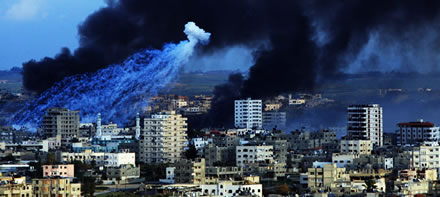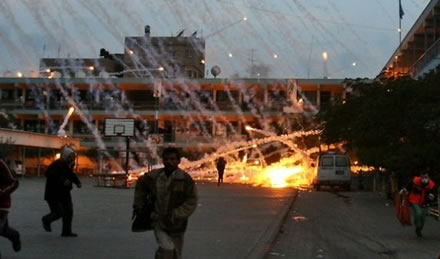Posted January 23, 2009
New! scroll down for videos from a recent forum on Gaza at NYU…
AS BARACK OBAMA mounted the Washington, DC inaugural stage on the historic morning of January 20, 2009, in Gaza the sounds of Israel’s invasion – the U.S.-supplied F-16s’ bombing runs, the artillery shells that accurately hit their targets of hospitals and clinics and refugee schools with children inside, the clearly-marked made-in-USA canisters of white phosphorus that burn people alive from the inside, the newly field-tested “DIME” bombs that efficiently tear multiple limbs off the victims – had gone at least temporarily silent.

There’s no doubt that the message had gone out quite explicitly to the Israeli leadership that it would be seen in very bad taste to upstage president Obama’s inauguration and first days in office by a continuing massacre in Gaza. So after three weeks and twelve or thirteen hundred dead, the Israeli government proclaimed a “unilateral ceasefire” claiming that its objectives of “crippling the military capacity of Hamas” were “substantially achieved.” Hamas for its part could claim “victory” in the fact of its survival and declare its own parallel cessation of rocket fire.
What are we to make of Israeli claims of success on the military level? From afar, our guess is that they’re probably partly true – in the sense that Hamas’s ability to operate militarily has been tactically weakened as much as could be done within the constraints imposed on this particular Israeli operation. This time around, a three-week Israeli campaign killing 1200-1300 Palestinians was acceptable (acceptable to whom? To U.S. imperialism, to Europe and to the complicit Arab regimes), but three months and killing twelve or thirteen thousand was not. This is no guarantee that the same limits will apply in the future.
Video from NYU Forum “The Assault on Gaza”
Bashir Abu-Manneh — Palestinian activist and Assistant Professor of English, Barnard College:
Stephen Shalom — Activist, author, and Professor of Political Science, William Paterson University:
This event took place on Friday, February 6, 7:00 PM at New York University.
But we need to understand, most importantly, that the military objectives stated by the Israeli leadership and embraced by the Bush administration were secondary at most, although relevant to Israel’s domestic politics. The real objective was the physical destruction of Gaza to the point where the democratically elected Hamas-led government would be utterly unable to function at the level of meeting people’s most primitive survival needs. Gaza’s police stations and government buildings, the medical infrastructure including civilian and Red Cross ambulances, the university, and the facilities of UNRWA (the United Nations agency providing relief in the Occupied Palestinian Territories) which is a major employer in the devastated Gazan economy – these were primary targets, and not by accident.
Here it must be admitted that the level of destruction and overwhelming human misery is impressive, and a tribute to both the efficiency of Israeli planning and the U.S.-Israeli special relationship. The lying pretext that the action was caused by Hamas breaking a six-month truce – a truce that Israel never honored for a single day, because the blockade and near-starvation of Gaza continued throughout – served its purpose of keeping the majority of Israeli Jewish public opinion in support of the slaughter. Israel’s Arab Palestinian minority expressed its growing outrage, supported by those principled Israeli Jewish antiwar forces who refuse to drink the regime’s propaganda Kool-Aid. Meanwhile that political gangster and extortion mafia known as the American Israel Public Affairs Committee (AIPAC) wagged its finger and achieved near-unanimity in both houses of the United States Congress for the cynical destruction of Gaza.
Whether the operation will achieve a political purpose is far less clear. The apparent aim of restoring Mahmoud Abbas, the now term-expired president of the Palestinian Authority, to power in Gaza on the strength of Israeli tanks and U.S., European and Middle East petrostates’ money, seems like a fantasy. Internationally a wave of anger has exploded, increasing the momentum for boycott, sanctions and divestment campaigns against the Israeli state. The new Obama administration has the job of shielding Israel from this rage – and it will undoubtedly exploit its enormous international credibility and goodwill to do so – but in turn it cannot afford to be discredited by highly visible, unrestrained Israeli brutality. Hence the timing of the cease-fire.
All the words available to describe the Gaza massacre – atrocity, crime against humanity, holocaust – have been taken. We have no new ones. But the cease-fire does not mean that the dying has ended. The people of Gaza do not have drinking water. The hospitals do not have medicines. The main UNRWA warehouse of food supplies went up in flames. The blockade of Gaza must end and the crossing points opened immediately. Every social justice organization in the world should place this emergency demand on the governments of Israel, Egypt and the United States. Everyone concerned with basic human decency should call for the end of all U.S. military aid to Israel. And every organization committed to human rights should apply its own principles to the crisis in Palestine just as it would to any other – and wherever those principles would call for sanctions, divestment or boycotts against regimes conducting massacres and ethnic cleansing elsewhere in the world, they should be applied to the state of Israel.

In a broader perspective, Gaza can be seen as the dying Bush administration’s parting gesture, completing its path of devastation — from Iraq eastward to Afghanistan and Pakistan, westward to Lebanon, Palestine and Somalia, to say nothing of the destruction of New Orleans and the U.S. economy. But it’s also an ominous warning for the future. These three weeks of horrific war against a whole population have done nothing – nothing – to solve the underlying crisis of Gaza. Most of its 1.5 million residents are the families violently uprooted from their lands and villages in southern Israel during the 1948 Nakba. Its once-thriving agriculture has long since been devastated by the poisoning and salinification of the water, by desperate overcrowding and by the destruction of orchards and fields for Israel’s “security zones.” Its growing population has no room to expand and no viable means of economic survival.
The crisis of Gaza can ultimately be “resolved” in one of two ways – either by a substantial Right of Return to its people’s homeland, or by a combination of mass expulsion and genocide. In the current political dispensation, neither of those is on the immediate horizon. But the time may be growing short.
— David Finkel, for the Political Committee of Solidarity
(For valuable information and statements on this continuing crisis, we suggest visiting the U.S. Campaign to End the Israeli Occupation, www.endtheoccupation.org).
